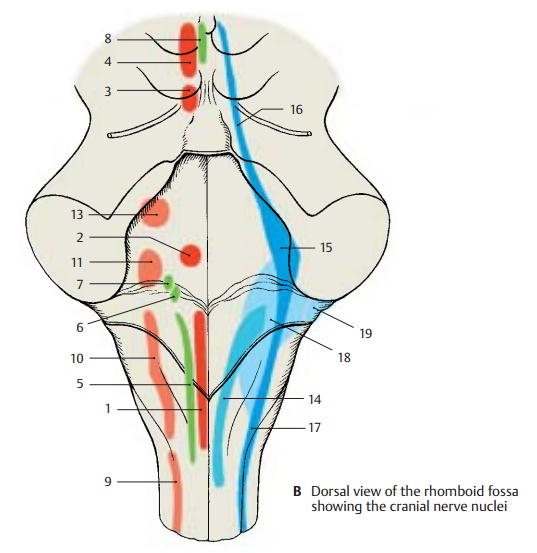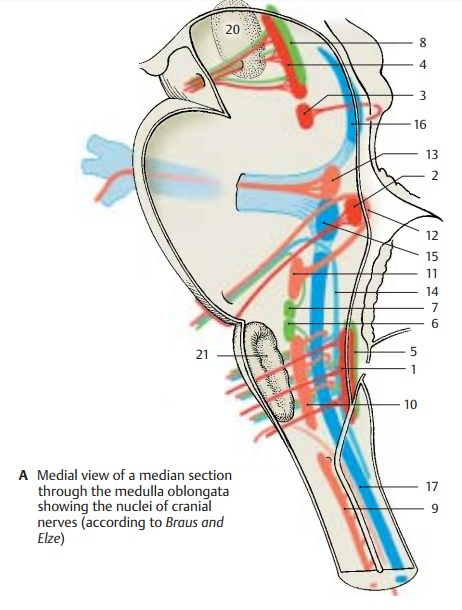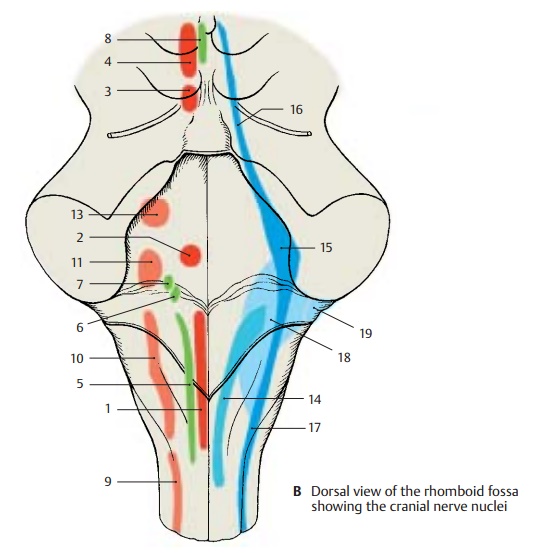Chapter: Human Nervous System and Sensory Organs : Brain Stem and Cranial Nerves
Cranial Nerve Nuclei

Cranial Nerve Nuclei
As in
the spinal cord, where the anterior horn represents the area of origin of motor
fibers and the posterior horn the area of ter-mination of sensory fibers, the
medulla ob-longata contains the nuclei
of origin (with the cell bodies of efferent fibers) and the nuclei of termination (for the axon
termi-nals of afferent fibers), the pseudounipolar cells of which lie in
sensory ganglia outside the brain stem. The somatomotor nuclei lie close to the midline:
The nucleus of the hypoglossal nerve (AB1) (tongue muscles)
The nucleus of the abducens nerve (AB2)
The nucleus of the trochlear nerve (AB3)
The nucleus of the oculomotor nerve (AB4) (eye muscles)
The visceromotor nuclei follow laterally,
namely, the genuine visceromotor nuclei belonging to the parasympathetic
nervous system and the originally visceromotor nu-clei of the transformed
branchial arch muscles. The parasympathetic
nuclei in-clude:
The dorsal nucleus of vagus nerve (AB5)
(viscera)
The inferior salivatory nucleus (AB6)
(pre-ganglionic fibers for the parotid
gland)
The superior salivatory nucleus (AB7)
(pre-ganglionic fibers for the submandibularand
sublingual glands)
The Edinger – Westphal nucleus (accessorynucleus of oculomotor nerve) (AB8) (pre-ganglionic fibers for the sphincter muscleof pupil and the ciliary muscle)
The
series of motor nuclei of the
branchialarch nerves begins caudally with the spinal nucleus of the accessory nerve (AB9) (shouldermuscles),
which extends into the cervicalspinal cord. The series continues cranially with
the ambiguous nucleus (AB10), which is the motor nucleus of
the vagus nerve and the glossopharyngeal nerve (muscles ofpharynx and larynx), and thenucleus of thefacial nerve (AB11) (facial muscles). The facialnucleus lies deep, as do all motor
nuclei ofthe branchial arch nerves. Its fibers run in a curve
directed dorsally, extend on the floor of the rhomboid fossa (facial
colliculus) around the abducens nucleus (internal
genuof facial nerve) (A12), and
then descendagain to the lower border of the pons where they emerge from the
medulla oblongata. The most cranial nucleus of the branchial arch nerves is the
motor nucleus of thetrigeminal nerve (AB13) (masticatorymuscles).

The sensory nuclei are located laterally;
most medially lies the viscerosensory soli-tary
nucleus (AB14), in which the
sensoryfibers of the vagus nerve and
the glos-sopharyngeal nerve, as well
as all taste fibers,terminate.
Further laterally extends the nu-clear area of the trigeminal nerve, which has the largest expanse of all cranial
nerves and consists of:
The pontine nucleus of the trigeminal nerve(principal
sensory nucleus) (AB15)
The mesencephalic nucleus of the trigeminalnerve (AB16)
The spinal nucleus of the trigeminal nerve (AB17)
All fibers
of the exteroceptive sensibility offace, mouth, and maxillary sinuses terminatein this area.

Finally,
most laterally lies the area of the ves-tibular
nucleus (B18) and the cochlear nucleus (B19), in which the fibers of the vestibularroot (organ of balance) and
the cochlear root (organ of hearing)
of the vestibulocochlearnerve terminate.
A20 Red nucleus.
A21 Olive.
Related Topics